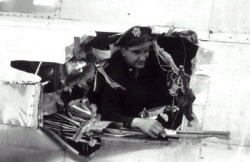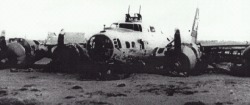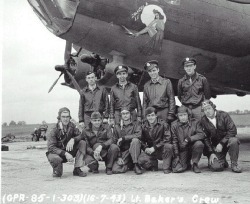By: Author Unknown
Date: 1999-11-03
Reprinted by permission of the 773rd Hostiles and Chuck "Creamo" Kremer.
This story was originally sent to Central of the 773rd Hostiles by one of the American Heroes from W.W.II, Willard "HAP" Reese: Pilot of B17 flying fortress. This article has been reposted here by permission of the 773rd Hostiles and Chuck "Creamo" Kremer.
Many stories have been written about the gallant defenses and the huge losses that were sustained by the Eighth Air Force as a result of Luftwaffe attacks on our bomber formations. And, to be sure, they were especially devastating and very often resulted in major losses of bombers and crews.

303rd Bomb Drop
Aircrew gunners have written time and again of the exchanges between their 50 caliber guns and the 20 millimeter cannons of the enemy and how bomber crews had fought off enemy planes and persisted in spite of the attacks. The "Memphis Belle" and "Twelve O'clock High" films are testaments to the tenacity of aerial combat.
I'm sure, however, that when the records are finalized and one looks closely at the losses, it will be determined that more B-17's were lost to antiaircraft fire than to FW190's or ME109's. One could not shoot back at "Flak" so it tended to be less glorious -- but nonetheless deadly.
Whenever there was heavy overcast we would encounter barrage type flak, that is, all antiaircraft guns were controlled by a central radar unit and all fired simultaneously causing hundreds of shell bursts in one general area and at one specific altitude. This was the kind of flak that was described as "heavy enough to walk on" -- and was the most deadly if it happened to be accurately placed.
On a clear day, when the antiaircraft gunners could see our formation, they were cleared to fire at any plane which they might pick out and adjust the direction and altitude of their shell bursts as they fired and as might be necessary. The quality of the German antiaircraft guns and the skill of their gunners made life miserable for those of us who had to fly straight and level through a sea of bursting flak and flying shrapnel. If "practice makes perfect", then the German gun crews were the best. Here is a typical German battery of four 88 milimeter antiaircraft guns and their crews firing in unison (barrage).
The following is about one of our many encounters with flak. It's about a German gun crew firing at a plane almost five miles above them. A gun crew whose accuracy and persistence almost brought to an end the tour of one crew of ten men in a B17 named "That's My Baby".

303rd BG
That's My Baby: February 16, 1945
This particular encounter occurred on Feb. 16th, 1945. It was our twenty-fourth mission and our target on this date was the synthetic oil facilities at Gelsenkirchen, Germany. The route of the 457th was on course and on schedule. The visibility in the target area was crystal clear with only light cloud cover at about 5000 feet. From the initial point to the target the flak was extremely heavy and accurate, something we had come to expect on a clear day such as this.
But this day, moreso than others, it seemed that each shell was bursting immediately adjacent to us and with each burst our plane shuddered a little as if fatally hit. Every plane in the squadron was taking a murderous beating from the flak.
Midway on the bomb run the deputy lead plane in the low box sustained a direct hit in his port wing between the number two engine and the fuselage. Almost immediately the wing folded up and broke off, almost colliding with another plane. The two parts of the plane spiraled out of control with fire billowing from each part as it fell. No one in our crew saw any parachutes. The intercom was ominously quiet. Weeks later we learned that six of the crewmen did not survive.
It was not unusual, after a visual bomb run with heavy flak, for the formation to break after dropping its bombs. Each plane would take its own evasive action to try to avoid the flak and then later reassemble with the squadron after leaving the target area. We felt safe from Luftwaffe fighters at this time since any attack while we were in the target area would also expose them to their own friendly flak fire.
On this day, immediately after dropping our bombs, we broke formation to the right from the high box and immediately were tracked by a single antiaircraft gun. The flak bursts were directly in front of the nose of our plane -- one after the other in rapid succession about 3 seconds apart. It seemed they were no more than 50 feet in front of the nose of our plane. The black bursts were unusually large and we were instantly engulfed in the residual smoke from the burst. We dove sharply and the flak followed.
We turned as tightly as a B17 can turn and the flak followed directly in front of us. Then suddenly we were hit. The explosion was in the nose compartment of the plane where the navigator and bombardier were located. Even with our helmets and headphones on, the sound was deafening. A fierce, cold wind suddenly blew through the pilot's compartment.

A quick glance at the instrument panel told me that engine number three had been hit. The oil pressure was dropping rapidly. Flying bits of aluminum gave me a clue that there was damage overhead in the pilots compartment and our instrument panel now had a major dent from the force of shrapnel hitting the forward side of the panel.
We immediately feathered engine #3 and cut the switches. Oil was streaming from the engine nacelle. I tried to contact Joel Lester in the forward compartment but could not. The silent intercom to the navigator's compartment only reinforced my belief that we had sustained major injuries.....or worse.
My worst fears were relieved when Joel's head appeared through the opening leading from the nose compartment to the flight deck. His oxygen mask had been blown off by the force of the wind and he was asking the flight engineer to get him the emergency portable oxygen bottle. We were still at 20,000 feet altitude and oxygen was an imperative. Joel shouted to me that he and the navigator "didn't have a scratch" but were about to freeze from the blast of subzero air now blowing through the front of the plane. The flak bursts were still coming but we were almost out of the range of the gun and were no longer concerned with evasive action.
A quick look upward told me that some flak had penetrated the fuselage above my head and there were several nicks in the bullet resistant glass of the windshield that had not been there before. Our bombardier and navigator crawled out of the nose and retreated through the pilots compartment to the radio room.

303rd BG: Bonnie B
From the rush of cold air we knew there was a major opening in the nose of the plane and the acrid smell of gunpowder lingered in the air. The air temperatures at this altitude in the winter frequently exceeded 40 degrees below zero.
We were now down to about 16000 feet and far from our squadron which was reassembling several thousand feet above us. With only three engines we were never able to catch up with our group but we were able to keep them in sight till we reached the English coast. Again we were fortunate that no fighters were in the area as the physical condition of our plane and our isolated location was a 'made-to-order' type kill for them.
Our bombardier, Joel, having found a throat mike and helmet in the radio room, proceeded to update me on what had happened. He reported that the burst had not been in the nose but directly in front of it. The shrapnel had shattered the plexiglas nose, damaged the bomb sight, and sprayed the nose compartment with deadly pieces of flying metal. It had miraculously spared both he and the navigator.
It seems that one of the pieces of shrapnel had hit a 50 caliber ammunition box on the floor adjacent to his foot and had exploded several shells which, in turn, had blasted a hole through the aluminum fuselage of the nose compartment without injuring him.
After crossing the Dutch coast we dropped down to about 2000 feet over the North Sea where the air temperature was considerably warmer. It had become unbearably cold in the pilot's compartment and, although it was February, the blast of air now flowing through our compartment felt comfortably warm.

We continued to Glatton on our three engines and landed without incident.
As I loosened my parachute to leave my seat and review the damage first hand, I observed that the flak fragment that had pierced the fuselage almost directly above my head had indeed come close. It was lodged in my parachute directly behind my left shoulder. I later dug out the fragment and still have it today. A souvenir of a close call -- both to the plane, the crew, and to me.
A slow walk around the plane made me aware of how fortunate we had been. The front end of the plane suffered major damage. The plexiglas nose was almost completely gone. There was a hole just above and to the starboard side of the navigator's compartment about a foot in diameter (where our exploding 50's had exited) and the chin turret was inoperable.
Furthermore, one of the two 50 caliber guns veered off at a sharp angle from the other. Several other fragments had punctured the fuselage in the navigator compartment, the leading edge of the right wing, and the cowling of the number three engine.

Damage from flak on B-17 #42-97329 Flak Hack 360BS
This was one of many episodes with flak. I cannot recall a mission where we were not under fire from antiaircraft guns for at least a portion of the time we were over enemy territory. This time our plane suffered major damage but none of the crew was scratched. We had a few silent prayers of thanks as we returned to our hut that night.
Addenda:
The following is an excerpt from official War Dept. document about "Flak" and the results of flak on the air war over Europe.
Fliegerabwehrkanonen ( FLAK ) Ack-Ack
The accuracy and effectiveness of FLAK or anti-aircraft artillery fire was derided at the start of the war but it gained a healthy respect as the war dragged on. By 1942 15,000 88mm ( 3.46 in ) guns formed the bulk of heavy flak defenses for Germany. Large numbers of 37mm ( 1.47 in ) and 20mm ( 0.79 in ) guns filled the skies with shells during every air raid. Often arrayed in "belts" around a city or target 88s could fire 22 lb ( 10 kg ) shells up to 35,000 ft ( 10,600 m ) at a rate of 15 - 20 rounds per minute.

303rd BG: Shillelagh
The excellent 88mm ( 3.46 in ) gun proved very effective especially when radar was used to help with aiming. The shells exploded at a preset altitude sending metal splinters flying in all directions. Later groups of up to 40 heavy flak guns Grossbatterien fired rectangular patterns of shellbursts known as box barrages that proved very deadly to enemy bombers.
In 1944 Flak accounted for 3,501 American planes destroyed, enemy fighters shot down about 600 less in the same time period. More flak guns gradually appeared, mainly the 128mm ( 5 in ) German Flak accounted for 50 of the 72 RAF bombers lost over Berlin on the night of March 24th, 1944. An incredible 56 bombers were destroyed or crippled by flak during a B-17 raid on Merseburg in November of 1944.

303rd BG: Lt. Baker's Crew
My thanks go to Willard "HAP" Reese and all the Heroes of W.W.II for their sacrifices to keep us free. I would also like to thank Central, Creamo and all the 773rd Hostiles for sharing this article. Thanks to Leo "Central" Park for gathering the information.
See also B17 Navigator's Diary and our Military History Index. Visit the 303rd Bombardment Group